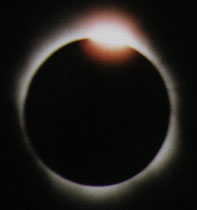 Diamond Ring at Second Contact!
Diamond Ring at Second Contact!I traveled February 21-28, 1998, with the Astronomical League (AL) Eclipse Cruise as part of Astronomical Tours by Spears Travel to the Caribbean on a Carnival cruise liner to see this year's total solar eclipse on February 26, 1998. Our group included 473 eclipse enthusiasts from all over the United States and the world. It was my first attempt at witnessing totality; my interest in solar eclipses was sparked by the May 10, 1994 annular eclipse that made it way through my home state of New Hampshire. I flew nonstop from Boston to San Juan on Saturday, February 21, and boarded our ship, the MS Fascination. After leaving San Juan, the Fascination went to St. Thomas, Guadeloupe, Grenada, Caracas, and Aruba in successive days. Our group had several interesting talks by various eclipse experts including Fred Espenak, Ken Willcox, and Mark Littmann.
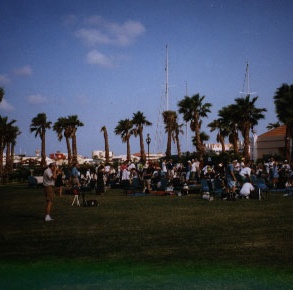 |
On the morning of Thursday, February 26th, I ate breakfast on the deck of the Fascination, docked in Oranjestad, the capital of Aruba, trying to decide where to view the total eclipse of the sun that would occur that afternoon. My options were to go ashore in Aruba and view the eclipse from land on the waterfront in Oranjestad or to stay aboard the Fascination which would sail southeast towards the centerline of the eclipse, offering about 35 seconds more totality in the open ocean. In addition, the ship also offered some mobility around clouds, enhancing the chance of witnessing totality. That morning, there were some cumulus clouds around Oranjestad, maybe 30% cloud cover. There is a prevailing northeasterly wind on Aruba from which all the weather comes, and that area of the sky looked promising. I also heard that morning clouds were very common and that they usually burned off by mid-morning. I really wanted to see the eclipse from land to attempt some photography, and to experience the eclipse and the environment from solid ground instead of from the deck of a ship. Weighing the two options, I decided I would get off the ship to witness three minutes and eight seconds of darkness at midday from Oranjestad.
 |
At about 8:30 am, I wheeled my equipment approximately four city blocks, with the help of Doug, a fellow eclipse chaser, to the AL's secure waterside viewing site, complete with uniformed guards. It was comforting to see that the eclipse experts were there setting up their equipment. After all, would they set up where they thought there was a poor chance of seeing totality? Shortly after arriving at the site, the weather improved slightly and there were just some scattered fair weather clouds. I set up my three tripods, one with a wide-angle automatic 35 mm camera, one with a camcorder, and one for a 35 mm SLR with a 300 mm zoom lens. We saw the Fascination leave for the centerline around 9:15 am and we waved to them, wishing them good luck. It turns out that we really needed the luck. All the shops on Aruba closed from noon to 3 pm for the eclipse, so we made a last run to get some film and drinks around 11:30 am. I purchased two different Aruban eclipse stamps, issued for this event, in the post office nearby. Jerry, a fellow observer, got me a first day cover, which were sold out by the time I got to the post office, for which I was very thankful.
Unfortunately, the weather became worse as the morning wore on, and it even rained lightly at 12:15 pm, shortly before first contact (12:38 pm). During the partial phases, we were in and out of the clouds, getting a twenty to forty second break every few minutes or so. As a result, many of the serious astronomers had trouble tracking the sun. I took a few photographs and video segments through my solar filters while monitoring the progress of the eclipse. I also checked out the equipment of others. Olivier Staiger, one of the people at our site, was putting real-time images of the eclipse onto his World Wide Web site, High Moon. A professional astronomer in our group from Cambridge, Massachusetts, was doing a diffraction experiment to measure electron density in the corona for her research. Some people had very elaborate equipment and telescopes. A few of the more serious observers had clock-driven equatorial mounts, while others just had cameras and possibly a camcorder (like me).
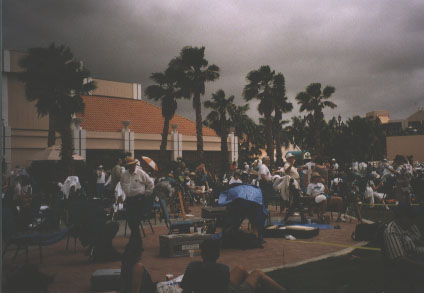 |
At about 1:15 pm, the clouds thickened up and it sprinkled lightly again. Everyone scrambled to keep their equipment dry. No blue sky could be seen anywhere. The weather did not look very promising to say the least, with less than an hour until totality (see GOES images). Everyone was looking pretty disappointed, and even the eclipse veterans among us were losing hope. With the poor weather, I really wished that I had stayed on the Fascination, fearing that I would be clouded out on my first attempt to see totality. Just twenty yards away, there was a helicopter and landing area which sold rides to give tourists aerial views of Aruba. I have to admit that paying the helicopter to take me to the Fascination was a thought that crossed my mind. The real kicker was several native Arubans coming by saying how unusual this weather was and how once it looks this bad, it takes a long while for the weather to improve. They also said it was first rain in six months! It was hard to remain optimistic. In addition, my two camcorder batteries were on the blink, dying after only twenty minutes instead of lasting for the specified one hour. Luckily, I had brought my charger and found an outlet to recharge one while I used the other.
However, about fifteen minutes before second contact, the weather began to improve a bit. We did begin to see some small blue patches of clear sky, and then we began to think that we might see a bit of totality. The eclipse was well advanced, and the clouds actually filtered the sun at times so that you could see the remaining crescent without filters. I changed the film and batteries in my cameras and attached the newly charged battery to the camcorder in preparation for a possible break in the clouds. With ten minutes to go, clouds only covered about two thirds of the sky. Perhaps a glimpse of totality would be possible. Everyone was quiet, perhaps praying for the break in the weather that we needed.
Then just four minutes before totality, the largest area of clear blue sky seen all day appeared in the northeast, perfectly placed with the prevailing wind to be overhead for totality. With much enthusiasm, I yelled out "look at that patch of blue sky--it's the best we have had all day." I also noticed and remarked that the sunlight was "very gray and very weird." In a matter of minutes, we went from thinking we not see much at all to having great viewing conditions, quite an emotional uplift. Soon the clear sky was overhead with about two minutes to go, but it was more gray than blue due the mostly eclipsed sun. The temperature was noticeably cooler than it was at first contact for the same reason. Excitement among those in the group quickly built. This eclipse was going to happen and we were going to see it all! It was quite a dramatic turn of events!
 |
As second contact approached, the light became increasingly dim at an accelerated rate. My heart began to beat faster. The remaining sunlight was a dim yellow gray, and our shadows on the ground became very sharp as the tiny remaining crescent sun approached a point source. On the ground, I could clearly see the shadows of the individual hairs on my head! Then I looked at my white poster board taped to the ground, and to my delight, I observed shadow bands with about ninety seconds to go. These perfectly parallel bands of light and dark, spaced about two inches apart, danced toward me, and I shouted "shadow bands" to alert others nearby. Someone else yelled "there's the shadow," referring not to the shadow bands, but to the oncoming umbra of the moon. I then looked to the southwest horizon out across the water and saw a markedly darkened sky. The lunar shadow was coming! Looking at my watch, I yelled "one minute, filters off" and took the solar filters off my cameras and camcorder. I checked my camcorder and I could see the emerging corona in the viewfinder, which I enthusiastically exclaimed to my fellow eclipse viewers. I was even more excited now, if this is possible. I started my automatic 35 mm camera to take exposures every twenty seconds to capture wide angle views of the corona and the visible planets, and I prepared my SLR camera to capture the first diamond ring. The excitement of everyone was clearly evident by their various reactions (verbal and otherwise) to the eclipse. The anticipation was tremendous.
I looked to the southwest and could see the nearby ocean rapidly darkening. As the last bits of the sun's photosphere were rapidly decreasing, I could tell that the shadow of the moon was very close, although I could not distinguish the distinct edge of the umbra. With fifteen seconds to go, someone yelled "there's Venus", and then I looked up to see the bright jewel in the southern sky, just uncovered by a passing cloud. Although I was in awe at the emerging sight of the corona, my hands somehow managed to operate my SLR camera, capturing the diamond ring through a series of shutter speeds. Over a few seconds, I could feel myself engulfed by the umbral shadow as I watched the diamond ring vanish. I was transfixed on the beautiful white solar corona that popped into view. The surroundings got dark enough so that I had difficulty reading. It was 2:09:46 pm, totality was here! Three minutes and eight seconds of darkness in the middle of the day!
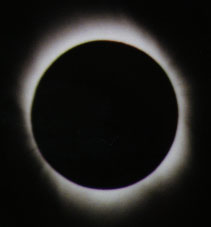 |
There were two long streamers in the corona, one going upward, slightly to the left and the other directly downward. The corona was composed of fine lines of white light with a living quality, not like any picture or video I have ever seen. The corona was bright near the edge of the moon and decreased intensity as you moved away. Short filaments to the left and right curved to joined the longer upper and lower streamers. Accompanying the corona were two bright naked eye planets--Jupiter was a few degrees below the corona and Mercury was just a few degrees to the upper left. I've never observed Mercury that bright! What a beautiful sight with solar corona being "escorted" by two bright planets. I then snapped a series of pictures of the entire corona at different shutter speeds, and then zoomed out to snap some photos with Mercury and Jupiter. About thirty seconds into totality, a native band started playing their kettle drums and guitars, and then some fireworks went off to the north of our location. Someone was sounding an air horn in the distance. I then noticed a small red-orange prominence on the top of the moon. I ran around my tripods, using my red-light flashlight, and grabbed my 10x50 binoculars. The corona more than filled its field of view. The fine structure of the corona was spectacular in the binoculars. I located the main prominence I had sighted earlier, plus a couple of smaller ones, and then carefully looked for other planets. I was rewarded by finding a fourth planet, fainter Saturn, just barely visible, far to the upper left of Mercury.
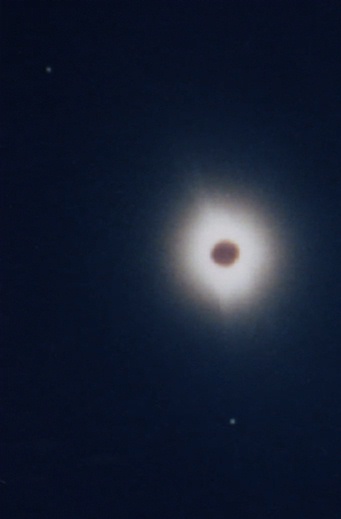 |
At that point, the edge of a small thin passing cloud filtered the corona for about a dozen seconds or so. Then, I heard a jet engine. Surely, a plane would not be landing during totality. However, I looked up and that is exactly what I saw, prompting me to yell look at that "G- D- plane landing." Sure enough, the jet liner with its lights flashing was on its final approach to Aruba's Queen Beatrix airport just to our south--in the middle of totality! This distraction was actually a blessing in disguise, as the jet called my attention to observe the southwest horizon which was a light yellow. I think that the numerous clouds in the area prevented the expected pink sunset color from appearing. I clearly remember saying to myself, you are now in the shadow of the moon, and feeling the power of the event. The horizon all around was this yellowish color, but it was a bit brighter to the southwest. Surely, the eclipse was not ending? Then someone yelled "twenty seconds," indicating that third contact and the end of totality was imminent. I ran back to my camera to capture the second diamond ring at the end of totality. I realigned my camcorder and got my SLR camera ready just in the nick of time. As I snapped photos, the red chromosphere then the first bit of photosphere appeared at the bottom right edge of the moon, forming a brilliant diamond ring. Totality ended at 2:12:54 pm, exactly as predicted by Fred Espenak, known as the "Michael Jordan of eclipse experts" by at least one of his colleagues. The landscape around quickly brightened as if someone was turning up a dimmer switch on the sun.
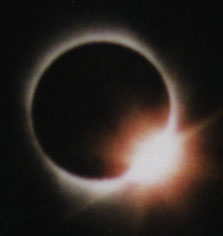 |
Everyone immediately celebrated. The atmosphere was quite emotional. It was amazing how cloudy it was and how fast the weather improved. Was the clear sky owed to the cooling that accompanied the eclipse, dropping the temperature just enough to prevent the convective clouds from forming? It was certainly much cooler at the end of the eclipse; one of the observers nearby measured a peak drop of 12 degrees F. Or was the perfectly timed, clear sky a result of some divine intervention? We will never know for sure, but I certainly got a taste of what it might be like to be clouded out of the most spectacular light show on earth.
A few minutes after total eclipse ended, the clouds were back in force, but not many people noticed. We were on an "eclipse high." Crystal, one of our travel agents who worked on planning this for over two years, was one of many showing tears of excitement and relief. Ken Willcox, the director of the trip, was also clearly overjoyed. He was more happy for those experiencing totality for the first time than he was for himself. There were high-fives and hugs everywhere. We had faced terrible weather just minutes before totality, yet still witnessed the corona in all its glory. I was interviewed by Aruban television, by a guy shooting a documentary film on eclipse in hopes of having it aired on PBS, and by several other enthusiasts. I told them that the only time I felt this kind of instantaneous, true excitement was on the birth on my son and on the birth of my daughter. A total solar eclipse is truly an experience that everyone should have at least once in their lifetime. However, as I was warned, total solar eclipses are addictive, and I personally want to see as many more as I can. Photographs and videos cannot accurately convey the appearance of the corona in person. Film and camcorders can capture portions of the corona--but only the human eye has the necessary dynamic range to view the bright inner corona and faint outer corona simultaneously.
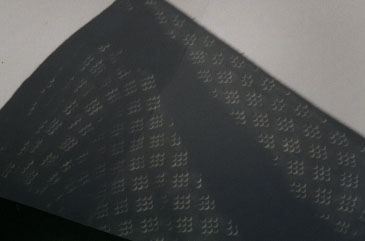 |
During the remaining partial phases, I took several photographs and some pictures of crescent suns on the ground through the small holes in the colander I had brought from home. Nancy, a school teacher from New York, had a dress with small holes, which served as tiny apertures to produce some nice little crescent suns on the ground (see picture to the right). By fourth contact, only a few diehards (including me) remained to see the moon move off of the disk of the sun, signaling the official end of the eclipse. I talked to some unfortunate observers who were about two miles down the coast from us who just got a few passing glimpses of totality. Still others at the south end of Aruba had cloudless skies. After some conversation and packing, we went to a bar down the street, and drank some Corona beer (how appropriate). Everywhere you went, the eclipse was what everyone was talking about. We were in the right place at the right time and there was not much margin for error. A bit more perplexing were the reports I heard of people who stayed inside the casinos during totality. One of my fellow observers sighted a tourist submarine surfacing a just few minutes after totality. Can you imagine missing out on this rare event on purpose?
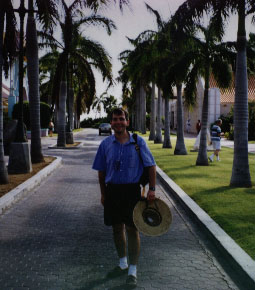 |
It turned out that the ship-based observers on the Fascination had some clouds and some rain while in transit, but had no clouds between first and fourth contact. They had ideal, clear sky conditions and saw the eclipse perfectly on the ship from the centerline location south and east of Aruba. It was nice that both groups were able to share in this rare astronomical event. For the record, the next total solar eclipse in Aruba is in 3388. The next total solar eclipse on our planet will cross central Europe from Great Britain to Turkey, then to Iran, Iraq, and India on August 11, 1999. I have already heard many people deciding to make the trip somewhere along the path of totality next year. After my first experience with a total eclipse of the sun, I now understand what a priviledged experience it truly is!
My thanks go to Ken Willcox, trip director, and Gary Spears, Adele Hitchcock,
and Crystal Ralph of Spears Travel for organizing the trip and expertly
handling the travel arrangements and other details for this trip. Most
importantly, they saw to it that the clouds moved out just in time. ;)
Maybe I will see you again in the shadow of the moon. Job well done!
Interesting Eclipse Links
Fred Espenak/NASA
Eclipse Home Page - Complete information on solar and lunar eclipses.
Clearly the most comprehensive eclipse site on the WWW. Very HIGHLY
Recommended!
Sky and Telescope Magazine - Good
resource not only on eclipses, but on many other aspects of astronomy
EclipseChaser - Total Solar
Eclipse web page by Jeffrey Charles
Earth View Eclipse Network -
Information on eclipses by Bryan Brewer, author of Eclipse
Eclipse!
Home Page - Information on eclipses by Phil Harrington, author of Eclipse!
Eclipse
Zone - Information on eclipses by Worachate Boonplod
Eric's
Black Sun Eclipse Website - An interesting site from a veteran of 5 total solar
eclipses (and counting!)
High Moon - Information on recent
and upcoming eclipses and astronomy by Olivier Staiger
Astronomical Tours - Future
total solar eclipse trips being organized by Ken Willcox and Spears Travel
My Personal Home Page -
Very much still under construction!
